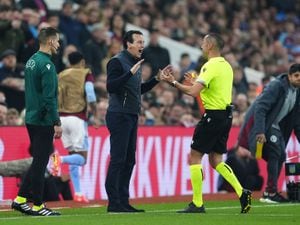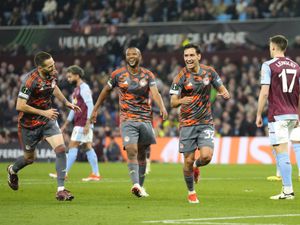Cliff's programme collection is a piece of history
The matchday programme has long been a staple of football throughout the world. But while these historic publications now appear under threat, collector Cliff Hague explains why they must not be consigned to the past and takes us through some of his most treasured programmes, which he has collated for his book Programmes! Programmes!
‘Programmes! Programmes! Get your programme here!’
For generations those cries made fans quicken their steps towards the turnstiles, the tunnel and the terraces, anticipating the excitement of that first view of the pitch and the gathering crowd.
Sadly, in the age of the mobile phone, the programme seller looks likely to become an endangered species. Derby County, Blackburn Rovers, Reading and Bristol City, along with Hibernian in Scotland, have stopped producing printed programmes. Others will follow.
Commercial viability looks likely to consign programmes to history – but programmes are history.
They endure long after the stadium has emptied, still telling stories of games frozen in time. They record how football itself has developed, along with the lives of players and fans.
Programmes leave footprints that we can follow to trace how lives and places changed from one generation to the next.
When I was a boy in the 1950s, Wolves were feared throughout England.
On a Wednesday night in November 1955 they hosted Moscow Dynamo in a glamour friendly under floodlights.
The programme for the match features in my book. It captures the occasion, and the times: the article by ‘Wanderer’ on page 3 began ‘History is made tonight’.
Although clubs had installed floodlights, they were not allowed to use them for League matches. So instead, midweek friendlies were arranged, preferably against exotic opponents.

Like millions of others, I watched Wolves take on the Russians live on TV. Black and white, of course, and only a 12 inch screen, when TVs were still a novelty, and live football was rarely screened.
Bill Slater opened the scoring after 15 minutes, with left winger, the pacey Jimmy Mullen, extending the lead in the second half, before Vladimir Ilyin pulled one back.
Tall, blonde and a good passer, Slater had joined Wolves from Brentford, but only because he had landed a job as a lecturer in physical education at Birmingham University. He approached legendary manager Stan Cullis to see if he could get a game for any of Wolves’ teams, as a side line to his main job. This was a man who had played in an FA Cup final (for Blackpool in 1951), the last amateur to do so. In the summer he played cricket for Warwickshire Seconds. None of this could happen today.
In theory, the men from Moscow were also amateurs. In reality they were the club of the Soviet internal security service. Levrenti Beria, Stalin’s notorious head of the secret police, was their patron, until his own execution in 1953.
Signing for Dynamo could scarcely have been more different than the way that Slater joined Wolves; it was an offer that could not be refused! The programme told Black Country readers how at a Dynamo floodlit home game, ‘the lights gleam on two huge pictures of Lenin and Stalin.’
The Russians played a different game on the field too. Stan Cullis was quoted in the programme as saying that every player was ‘a soccer technician’. They were described as ‘crisp, nippy, mobile players’ who had been trained to play in ‘almost any position’. Their emphasis was on ‘slick movement, positional play and distribution of the ball’, and ‘the knack of mixing the short- and long-passing game.’ Such qualities were not common in the England at that time.
The line-ups of the teams in the centre-fold pages are revealing.
For Wolves it was Bert Williams in goal; then numbers two and three, Stuart and Shorthouse as full-backs behind the formidable half back trio who would represent England in the 1958 World Cup finals, Slater, skipper Billy Wright and Eddie Clamp. Then the forward line, numbered seven to 11, read Hancocks, Broadbent, Murray, Wilshaw and Mullen.
In contrast, Dynamo had the great Lev Yashin in goal, then a back three, behind numbers five and six, Boykov and Sokolov, then again five attackers.
Wolves had already played in Moscow, so more than most British teams knew that continentals typically played, and numbered, with a back three.
Britain was slow to adapt. Journalist Ivan Sharpe wrote in the programme, ‘the chess-like football, which some people said wouldn’t suit our crowds, has been developed abroad with telling effect.’
Albion were also a formidable side in the mid-1950s. In 1953/54 they nearly achieved a league and cup double, a staggering feat in those days. It was Wolves who thwarted them, crowned champions with 57 points from a 42-game season, with Albion second just four points behind. It was two points for a win in those days, and Albion had gathered only three points from their last seven games.
The slump came immediately after the FA Cup semi-final, in which they had overcome giant-killers Port Vale 2-1 at Villa Park.

The programme for the Cup final 3-2 victory over Preston North End at what was still called ‘The Empire Stadium’ described how their progress in the league and cup had earned them the moniker ‘team of the century’, another indication of how exceptional their achievements were seen to be.
While England captain Billy Wright was married to one of the Beverley Sisters – the nearest thing to the Spice Girls in the mid-1950s – Albion’s Cup winners achieved success without celebrity internationals.
The pen portraits in the Wembley programme capture it well.
Left-back Len Millard was captain. He had joined the club in 1937 from the Sunbeam Works team, and made his debut in 1942. Right winger Frank Griffin was ‘fast, slightly-built…a team player in the real sense of the word’. On the other wing, George Lee had ‘developed his pace during his army service’.
The star of the team, centre-forward Ronnie Allen (whose autograph I still have) was ‘one of the smallest leaders in the game’, and had signed from Port Vale as a winger. At five feet eight inches (1.73 metres) and just 10 stone (63.5kg) he was quite different from the typical number nine. ‘Quick thinking and speed off the mark’ were what had made him an England international, and a player ahead of his time.
Allen had an interesting managerial career, as I mention in my book. After taking Wolves out of the Second Division in 1967, he broke new ground and took over at Bilbao.
In 1972 he was managing Sporting Lisbon in a European Cup Winners Cup game against Hibernian. At a time when British clubs were almost entirely composed of white people born in Britain, the match programme shows that Sporting included Brazilians, players from Angola and black Portuguese players in their squad.
At the end of that season Allen swapped the sunshine of Portugal for the more bracing climate of Walsall, and would go on the manage Albion briefly, before moving abroad again.
One game more than any other marked to arrival of black players at the highest level in this country. I was there and have the programme, which in its way marks a milestone in black history. On December 30, 1978, I took my seven-year-old son to Old Trafford for the visit of the table-topping Baggies.
The Albion team photo included three black players who would become famous by the final whistle.
The programme notes highlighted ‘the exciting attacking skills of their coloured forwards’, who proceeded to inspire a 5-3 win for the visitors. The fact that their skin colour was referenced says a lot about society and football in those days.
Despite being constantly booed when they had the ball, Brendon Batson, Cyrille Regis and Laurie Cunningham provided a spectacle of skill and power.
Without taking anything away from two-goal Tony ‘Bomber’ Brown, the dynamic Brian Robson, or the others in the Albion side, the abiding memory is Cunningham’s silky pace and the power of Regis, never more so than when he smashed home the final goal.
Respect may have been given grudgingly, but it could no longer be denied.

Programmes! Programmes! Football and Life from Wartime to Lockdown by Cliff Hague is published by Pitch Publishing, in hardback and as an e-book: 384 pages with 15 action photos and 63 programme pictures. Available from all good bookshops and online booksellers.
Villa produced their first programme for their meeting with Blackburn Rovers on September 1, 1906, a game they won 4-2. It cost one penny.
The front cover advert for Rover cycles splendidly illustrates the social distinctions of the age. ‘When you see a cyclist on a “ROVER” you can be sure that he or she have paid for their bicycle. We do not “touch” the penny or twopence a day business.”
The back cover carried an advert for the McGregor Football Boot. Just looking at the illustration is enough to scare all but the bravest. The 12 pairs of eyes for laces reached from the toe to half way up the shin. The toe cap itself amounted to a warning to any opponent reluctant to countenance a permanent limp for the rest of his life.
The programme provided insights into football finances in that era. With the current controversy about the Saudi takeover of Newcastle United, it is fascinating to read that Newcastle had been 1905’s most financially successful club, recording a profit of £4,399, equivalent to something over half a million today.
In contrast, Chelsea’s loss of some £5,000 was ‘little less than stupendous’. They had spent heavily to try, unsuccessfully, to win promotion to the First Division. Despite the threats to their wealth from the 1905 Russian Revolution, no oligarchs came to the London club’s rescue.
The programme also explained how Villa had built a gymnasium under the stand and provided their employees with a reading room and ‘well-equipped’ library, ‘containing all that could reasonably be required for the well being and edification of the players’. Might the prospect of ‘edification’ still appeal in a world of Instagram and Tik Tok? Perhaps not.





